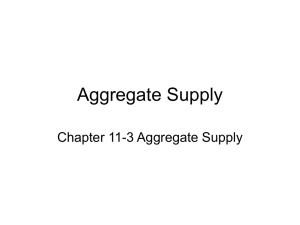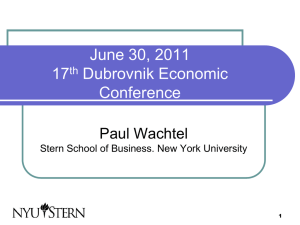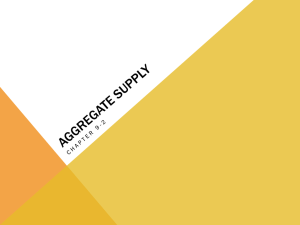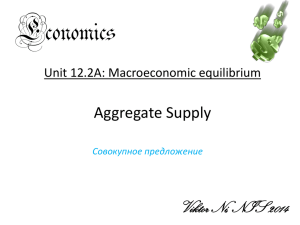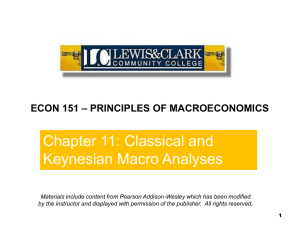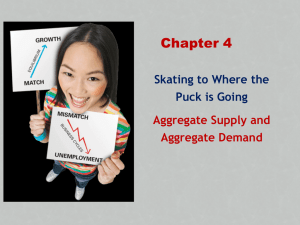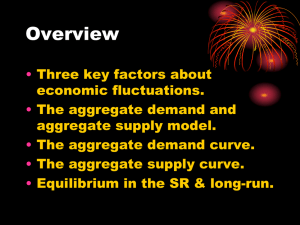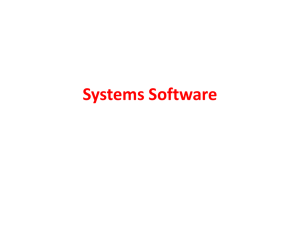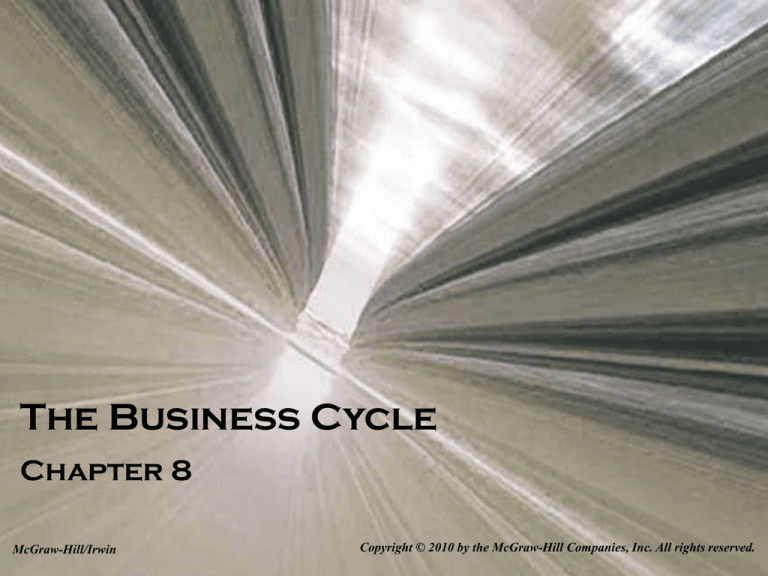
The Business Cycle
Chapter 8
McGraw-Hill/Irwin
Copyright © 2010 by the McGraw-Hill Companies, Inc. All rights reserved.
The Business Cycle
• Basic purpose of macroeconomics is to explain
how and why economies grow and what
causes recurrent ups and downs
– How stable is a market-driven economy?
– What forces cause instability?
– What, if anything, can the government do to
promote steady economic growth?
8-2
Macroeconomics
• Macroeconomics: The study of aggregate
economic behavior, of the economy as a whole
• Business cycle: Alternating periods of
economic growth and contraction
• Macro theories try to explain the business
cycle, economic policies try to control it
8-3
Stable or Unstable?
• Prior to the 1930s, macroeconomists thought
there could never be a Great Depression
• They believed a market-driven economy was
inherently stable
• Laissez faire: The doctrine of “leave it alone,”
of nonintervention by government in the
market mechanism
8-4
Classical Theory
• According to the classical view, the economy
“self-adjusts” to deviations from its long-term
growth trend – a self-regulating economy
• The cornerstones of classical optimism were
flexible prices and flexible wages
8-5
Classical Theory
• Say’s Law: Supply creates its own demand
– Whatever was produced would be sold
– All workers seeking employment would be hired
• Unsold goods and unemployed labor could
emerge, but both would disappear once people
had time to adjust prices and wages
8-6
Macro Failure
• The Great Depression was a stunning blow
– Unemployment grew and persisted despite falling
prices and wages
– The classical self-adjustment mechanism simply
didn’t work
8-7
Inflation and Unemployment: 1900-1940
24
20
Unemployment
16
12
8
4
0
Inflation
–4
–8
1900
1910
1920
1930
1940
Source: U.S. Bureau of the Census, The Statistics of the United States, 1957
8-8
The Keynesian Revolution
• John Maynard Keynes developed an alternate
view of the macro economy, asserting that a
market-driven economy is inherently unstable
– Small disturbances in output, prices, or
unemployment were likely to be magnified by the
invisible hand of the marketplace
8-9
Government Intervention
• In Keynes’ view, the inherent instability of the
marketplace required government intervention
– We can’t afford to wait for some assumed selfadjustment mechanism
– Must intervene to protect jobs and income
8-10
Historical Cycles
• Upswings and downturns of the business cycle
are gauged in terms of changes in total output
• Real GDP: The value of final output produced
in a given period, adjusted for changing prices
• Changes in employment typically mirror
changes in production
8-11
The Business Cycle
Peak
Growth trend
REAL GDP
Peak
Peak
Trough
Trough
TIME
8-12
The Business Cycle
• An economic upswing (expansion) is an
increase in the volume of goods and services
produced
• An economic downturn (contraction) occurs
when the volume of production declines
• Successive short-run contractions and
expansions are the essence of business cycles
8-13
The Business Cycle
• Recession: A decline in total output (real
GDP) for two or more consecutive quarters
• Growth recession: A period during which real
GDP grows, but at a rate below the long-term
trend of 3 percent
8-14
The Business Cycle in U.S. History
Source: U.S. Department of Commerce (2009)
From 1929 to 2009, real GDP increased at an average rate of 3 percent a year.
8-15
Business Slumps
Dates
Duration
(months)
Percentage
Decline in
Real GDP
Peak
Unemployment
Rate
Aug. ‘29–Mar. ‘33
43
53.4%
24.9%
May ‘37 –June ‘38
13
32.4
20.0
Feb. ‘45 –Oct. ‘45
8
38.3
4.3
Nov. ‘48–Oct. ‘49
11
9.9
7.9
July ‘53–May ‘54
10
10.0
6.1
Aug. ‘57–Apr. ‘58
8
14.3
7.5
Apr. ‘60–Feb. ‘61
10
7.2
7.1
Dec. ‘69–Nov. ‘70
11
8.1
6.1
Nov. ‘73–Mar. ‘75
16
14.7
9.0
Jan. ‘80–July ’80
6
8.7
7.6
July ‘81–Nov. ‘82
16
12.3
10.8
July ‘90–Feb. ‘91
8
2.2
6.5
Mar. ‘01–Nov. ‘01
8
0.6
5.6
Dec 07–
?
?
?
8-16
A Model of the Macro Economy
• Both Keynes and the Classical economists
agreed that business cycles occur, but
disagreed on whether they’re an appropriate
target for government intervention
• Need to understand origins of the business
cycle
8-17
Macroeconomic Performance
• Macro outcomes include:
–
–
–
–
–
Output - Value of goods and services produced
Jobs - Levels of employment and unemployment
Prices - Average price of goods and services
Growth - Year-to-year expansion in production
International balances - International value of the
dollar; trade and payments balances with other
countries
8-18
Macroeconomic Performance
• Determinants of macro performance include:
– Internal market forces - Population growth,
spending behavior, intervention & innovation, etc.
– External shocks - Wars, natural disasters, terrorist
attacks, trade disruptions, and so on
– Policy levers - Tax policy, government spending,
changes in the availability of money, and
regulation, for example
8-19
The Macro Economy
DETERMINANTS
OUTCOMES
Internal
market
forces
Output
Jobs
External
shocks
MACRO
ECONOMY
Prices
Growth
Policy
levers
International
balances
8-20
Aggregate Demand and Supply
• Any influence on macro outcomes must be
transmitted through supply or demand
• Aggregate demand: The total quantity of
output (real GDP) demanded at alternative
price levels in a given time period, ceteris
paribus
8-21
Aggregate Demand
• The aggregate demand curve illustrates how
the real value of purchases varies with the
average level of prices
• The downward slope suggests that with a
given (constant) income, at lower price levels
people will buy more goods and services
8-22
PRICE LEVEL
Aggregate Demand
Aggregate demand
REAL OUTPUT
8-23
Aggregate Demand
• Three reasons for the downward slope:
– Real-balances effect - a change in the price level
affects the purchasing power of money
– Foreign-trade effect - balance of trade depends on
domestic price level relative to foreign
– Interest-rate effect - change in price level affects
demand for loan-financed purchases
8-24
Aggregate Supply
• Aggregate supply: The total quantity of
output (real GDP) producers are willing and
able to supply at alternative price levels in a
given time period, ceteris paribus
• Two reasons for upward sloping curve:
– The profit effect
– The cost effect
8-25
Aggregate Supply
PRICE LEVEL
Aggregate supply
REAL OUTPUT
8-26
Macro Equilibrium
• Aggregate supply and demand curves
summarize the market activity of the whole
(macro) economy
• Equilibrium (macro): The combination of
price level and real output that is compatible
with both aggregate demand and aggregate
supply
8-27
Macro Equilibrium
PRICE LEVEL
Aggregate
supply
P1
E
Macro equilibrium
PE
Aggregate
demand
D1
QE
S1
REAL OUTPUT
8-28
Macro Failures
• Potential problems with macro equilibrium:
– Undesirability - the equilibrium price or output
level may not satisfy policy goals
– Instability - even if the designated macro
equilibrium is optimal, it may not last long
8-29
An Undesired Equilibrium
PRICE LEVEL
Aggregate
demand
PE
Aggregate
supply
E
F
P*
Equilibrium
output
QE
Full-employment output
QF
8-30
An Undesired Equilibrium
PRICE LEVEL
Aggregate
demand
PE
Aggregate
supply
E
Desired
price level
F
P*
Equilibrium
output
QE
QF
8-31
Instability
• Macroeconomic equilibrium changes
whenever the aggregate supply and/or demand
curves shift
• Business cycles are likely to result from
recurrent shifts of aggregate supply and
demand curves
8-32
AS and AD Shifts
• Shifts in aggregate supply can be caused by
changes in costs of production due to import
prices, natural disasters, changed tax policies,
or other events
• Shifts in aggregate demand can be caused by
changes in export demand, expectations, taxes,
or other events
8-33
Macro Disturbances
(a) Supply shifts
(b) Demand shifts
AS1
AS0
AS0
P1
P*
G
F
PRICE LEVEL
PRICE LEVEL
AD0
P*
P2
F
H
AD0
AD1
Q1 QF
REAL OUTPUT
Q2 QF
REAL OUTPUT
8-34
Competing Theories of Short-Run
Instability
• Macro controversies focus on the shape of
aggregate supply and demand curves and the
potential to shift them
• Demand-side theories, such as Keynesian and
Monetary, emphasize aggregate-demand shifts
• Supply-side theories center on shifts in supply
8-35
Demand-Side Theories
(a) Inadequate demand
(b) Excessive demand
AS0
P*
PRICE LEVEL
PRICE LEVEL
AS
E0
E1
E2
P2
P*
E0
AD2
AD0
AD0
AD1
Q1 QF
REAL OUTPUT
QF Q2
REAL OUTPUT
8-36
Keynesian Theory
• Keynes argued that a deficiency of spending
tends to depress an economy and cause
persistently high unemployment
• Advocated increasing government spending –
a rightward AD shift – to move the economy
toward full employment
8-37
Monetary Theories
• Monetary Theories emphasize the role of
money in financing aggregate demand
• Money and credit affect ability and willingness
to buy goods and services
• If credit isn’t available or is too expensive
consumers reduce spending and businesses
curtail investment
8-38
Supply-Side Theories
• Inadequate supply can keep the economy
below its full-employment potential and cause
prices to rise as well
• Increases in aggregate supply move us closer
to goals of price stability and full employment
8-39
Supply-Side Theories
AS1
PRICE LEVEL
AS0
E3
P3
E0
P0
AD0
Q3
QF
REAL OUTPUT
8-40
Long-Run Self Adjustment
• Some economists argue that the long-run trend
of the economy is what really matters, not
short-run fluctuations
• They assert a long-run aggregate supply curve
anchored at the natural rate of output (QN)
– Flexible prices (and wages) enable the economy to
maintain the natural rate of output QN
8-41
The “Natural” Rate of Output
PRICE LEVEL
AS
P2
P1
AD2
AD1
QN
REAL OUTPUT
Fluctuations in aggregate demand affect the price level but not real output.
8-42
Short vs. Long-run Perspectives
• The long-run aggregate supply curve is likely
to be vertical at QN
• The short-run aggregate supply curve is likely
to be upward-sloping
• Both aggregate supply and aggregate demand
influence short-run macro outcomes
8-43
Policy Strategies
• Shift the aggregate demand curve: Use policy
tools that affect total spending
• Shift the aggregate supply curve: Implement
policy levers that influence the costs of
production or otherwise affect output
• Laissez-faire: Don’t interfere with the market;
let markets self adjust
8-44
Selecting Policy Tools
• There are a host of tools available:
–
–
–
–
–
Classical laissez faire
Fiscal policy
Monetary policy
Supply-side policy
Trade policy
8-45
Policy Tools
• The laissez-faire approach requires no tools,
as the economy naturally self-adjusts to full
employment
• Fiscal policy: The use of government taxes
and spending to alter macroeconomic
outcomes
8-46
Policy Tools
• Monetary policy: The use of money and
credit controls to influence macroeconomic
outcomes
• Supply-side policy: The use of tax incentives,
(de)regulation, and other mechanisms to
increase the ability and willingness to produce
goods and services
8-47
Policy Tools
• Trade policy can be used to affect
international trade and money flows and shift
the aggregate demand and/or the aggregate
supply curve
8-48
The Business Cycle
End of Chapter 8
McGraw-Hill/Irwin
Copyright © 2010 by the McGraw-Hill Companies, Inc. All rights reserved.

